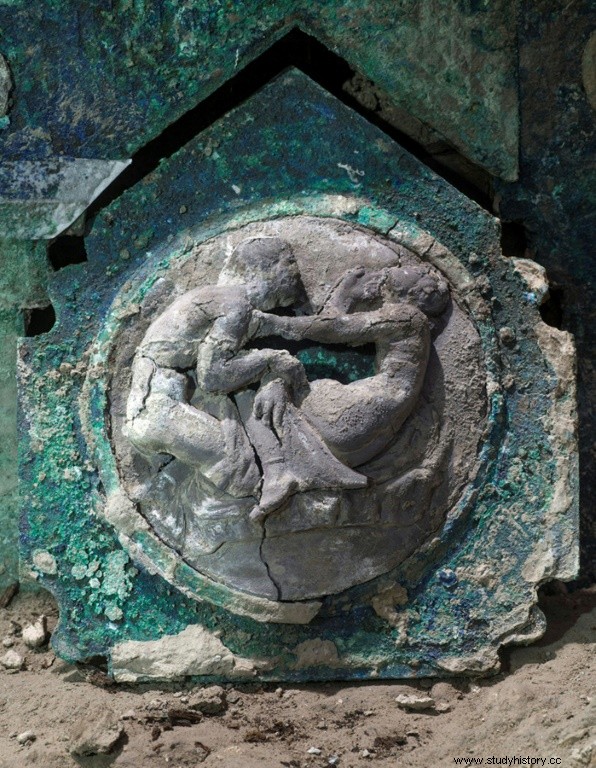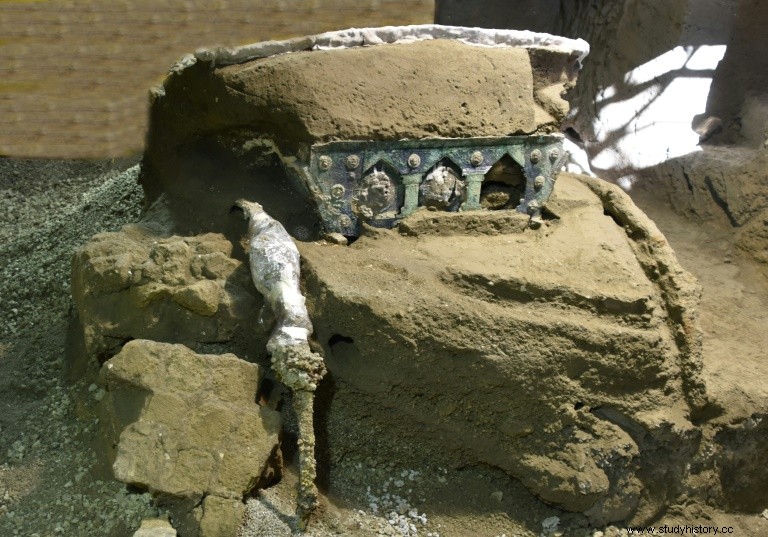The archaeological park of Pompeii announced the discovery of a large ceremonial chariot, found in excellent condition.

Photo provided by Pompeii National Park on February 27, 2021, of a Roman-era ceremonial chariot discovered near the archaeological site of Pompeii, Italy
The Pompeii Archaeological Park announced on Saturday the discovery of a large ceremonial chariot, found in an excellent state of preservation, just a few hundred meters north of the famous Italian cultural site.
"A large four-wheeled ceremonial chariot, with its iron elements, beautiful bronze and pewter decorations, remains of mineralized wood, imprints of organic elements (from ropes to the remains of vegetable decorations), was found almost intact," reads a statement from the Archaeological Park.
The tank was discovered in a porch in front of a stable where, already in 2018, the remains of 3 equines, including a harnessed horse, had been found, the statement said.
This discovery was made in Civita Giuliana, a district located seven hundred meters north of the archaeological park of Pompeii.

Photo provided by the Pompeii National Park on February 27, 2021, of a Roman-era ceremonial chariot discovered near the archaeological site of Pompeii, Italy (POMPEI ARCHAEOLOGICAL PARK/AFP - Handout)
It was carried out in the context of the fight against tomb robbers (tombaroli), particularly active in this area of Italy, full of archaeological treasures still to be discovered.
"Pompeii continues to amaze us with its discoveries and it will be like this for many years to come, with another 20 hectares to be excavated," said Minister of Culture Dario Franceschini, quoted in a press release from his ministry.
"It is an extraordinary discovery for the knowledge of the ancient world. In the past we found in Pompeii vehicles of transport like that of the house of Menander, or even two chariots in the Villa Arianna, but nothing similar to the chariot of Civita Giuliana", rejoiced the outgoing director of the archaeological park, Massimo Osanna, quoted in the press release.
"It is a ceremonial float (...) not used on a daily basis or for agricultural transport, but to accompany community celebrations, parades and processions," added the expert. From the vehicle have been preserved medallions with delicate decorations in bronze and pewter with erotic themes perhaps linked to the cult of Ceres and Venus,

Photo provided by the Pompeii National Park on February 27, 2021, of a Roman-era ceremonial chariot discovered near the archaeological site of Pompeii, Italy (POMPEI ARCHAEOLOGICAL PARK/AFP - Handout)
Like most Italian cultural sites, Pompeii, buried by the eruption of Vesuvius in 79 AD, has remained closed for the past few months due to the Covid pandemic and only reopened on January 18.
In 2019, the site welcomed more than 3.9 million visitors, making it the third most visited site in Italy after the Colosseum in Rome and the Uffizi Museum in Florence.
